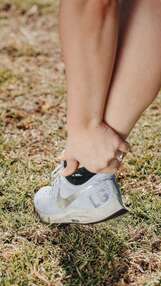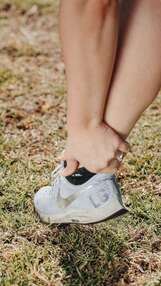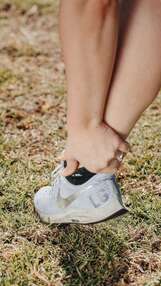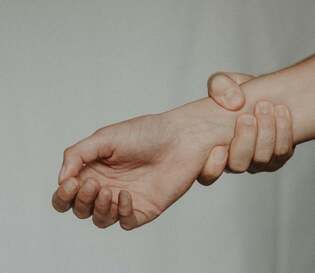|
Chronic ankle instability is an instability affecting the ankle joint and its surrounding structures. It usually develops after a severe ankle sprain. However some people are born with less stable ankles, who may be generally extra flexible throughout their entire bodies. Approximately 20% of ankle sprains lead to chronic ankle instability due to the resulting changes in ligament support, strength, postural control, muscle reaction time and sensation. What are the symptoms?
As well as being more susceptible to ankle sprains, people with chronic ankle instability may notice they are extra cautious during high-intensity activities, if walking or running on uneven surfaces or when changing directions quickly. They may experience a sense of weakness or "giving way" when weight-bearing. What are the causes? The primary causes of this condition are ligament laxity, decreased muscle strength of the muscles surrounding the ankle and reduced proprioception. Following an ankle sprain, ligaments can be stretched and slightly weaker. In more severe cases, they may have torn altogether, leaving the ankle structurally weaker. Without full rehabilitation, the surrounding muscles also become weaker, and studies have shown that balance and sensation of the ankle can also be reduced. This means that the ankle is more likely to be injured again, creating a vicious cycle leading to further instability. How can physiotherapy help? Physiotherapy treatment for chronic ankle instability focuses on improving strength, control and balance with a variety of techniques. This approach can significantly improve dynamic ankle stability and reduce the risk of future sprains. Physiotherapists can help patients to regain confidence and get back to their best performance. In some cases, taping or bracing for support can be used. However this can lead to dependence and further loss of strength and control if used unnecessarily. In cases of extreme ligament laxity or if physiotherapy fails, surgery to repair the damaged ligaments is considered. This is usually combined with a full post-operative physiotherapy rehabilitation program for greatest success.
0 Comments
The lower part of the leg, from the knee down to the ankle consists of two long bones that sit side by side- the thicker tibia and the thinner fibula. The bones are joined together by thick fibrous connective tissue called a "syndesmosis" and are firmly attached to each other with just a small amount of movement between them, allowing for a small amount of rotation of the ankle. A fracture of the fibula occurs when the bony tissue is disrupted or broken. It is a common injury and can occur at any part of the bone, depending on the mechanism of injury or the state of the bone. How does it happen?
A fracture of any bone can occur when the force applied to any point exceeds the strength of the bone at that point. However, as with all fractures, there are common patterns that are seen based on structural points of weakness in the bone and common patterns of movement. A few common ways that the fibula is broken are... Blunt force: If something hits the bone hard enough, it will break on impact. This could include being hit by a ball hard enough or being hit by a car, as this is the site where a car's bumper would reach. Impacts like this that have enough force will often break both the tibia and the fibula at the same time. Skiing accidents where skis hit something suddenly or get stuck can also cause the bones to break at the upper level of the ski boots. Ankle Sprain: When it comes to the fibula, the most common reason for the bone to be broken is during a severe ankle sprain. The ligaments that attach the outside of the foot to the fibula are so strong that when you twist your ankle badly enough, sometimes it is the bone that breaks. This is one of the most commonly missed injuries, partly because the fibula is not a weight-bearing bone. This means that after the initial pain and swelling have subsided, you can still walk on your foot without pain stopping you. It is important to have any severe ankle sprains imaged by X-ray to rule out any fibula fractures. What are the symptoms? In some cases, the symptoms of a fibula fracture will be unmistakable, with severe pain. Sometimes the skin will be broken and there will be bleeding. If the bone has been moved from its usual position, there will be a deformity such as a bump or dip under the skin. For smaller, undisplaced fractures, there will be pain over the bony aspects and a constant, deep pain that is worse when weight-bearing. What is the treatment? Physiotherapists are often the first to notice fractures caused by ankle sprains. Once a fracture has been confirmed, your medical team will decide on the best course of action to allow the bones to heal. This might include surgery to pin the bones together, casting or the use of a moon boot. Following a period of immobilisation, your physiotherapist can help you rehabilitate the surrounding tissues. This will include muscle strengthening, joint mobilisation, balance and control retraining, and a stretching program. Ankle sprains are extremely common, however this doesn’t make them easy to cope with when they happen to you. If you’ve ever spent two weeks hobbling around on crutches after a bad twist, you’ll understand just how painful and difficult they can be. What are they?
An ankle sprain refers to an overstretch or tear to the ligaments of the ankle. Commonly, a person will roll their ankle inwards and tear the ligament on the outside. Occasionally, the ankle will twist outwards and the ligaments on the inside of the ankle are torn and even less commonly, the fibres of the ligament that hold the two bones of the lower leg together can tear (this is a "high ankle sprain"). A sprained ankle will usually be painful, swollen, bruised, difficult to walk on and in some cases unstable. How does it happen? Ankle sprains can occur from something as simple as putting weight onto your leg when you think your foot is flat even though it’s not. The most typical pattern is of a person jumping and landing on the outside of their foot or simply slipping and twisting their ankle. A sprained or twisted ankle is one of the most common injuries presented to hospital emergency departments around the world. A medical or health professional should assess any ankle sprain. However, there are some guidelines to help decide if a sprained ankle needs an X-ray... 1. You are unable to put weight on the ankle immediately after the injury. 2. You are unable to take more than 4 steps immediately after the injury. 3. You have pain on the bony edges of the outer foot and ankle. How long do sprains take to heal? Depending on the severity of the tear, from one to six weeks. Your physiotherapist is able to help with recovery and ensure nothing slows down the healing process. Following any injury, joints may remain a little stiff and lose strength and control. Even though the injured tissues have healed, the ankle doesn’t move quite the way it used to. This means that your risk of twisting it again is higher than before the injury. How can physiotherapy help? Correct rehabilitation can help to speed up your recovery and prevent recurring injuries. As well as providing support to the unstable ankle, your physiotherapist will help you to strengthen any weak muscles and restore balance and control through exercise. They are also able to correct any abnormal movement of the joint following the injury. Strains and sprains are words that are used almost interchangeably when describing injuries, however they each have quite distinct meanings. The most straightforward explanation is that a “strain” refers to an injury in a muscle or tendon, while a “sprain” refers to an injury to a ligament. Here we describe what that means and how we treat strains and sprains differently. Ligaments are fibrous tissues that connect and hold bones to other bones at your joints. These are very strong parts of your anatomy and provide large amounts of support and stability to the body.
Some ligaments are so strong that sometimes a bone will break before the ligament will tear. When ligament fibres do tear, the nearby joint can feel unstable as it has lost some of its structural support. A torn ligament will usually become painful and swollen, it may appear red and warm to touch and occasionally there will be some bruising. The pain will be worse with movement or if the ligament is placed under more stress. Occasionally, if a ligament has torn all the way through, the pain will not be as severe as it is with a partial tear. Your physiotherapist can grade the severity of a ligament sprain, which will help guide treatment and expected recovery times. Muscle strains are easy to confuse with ligament sprains, however, there are a few tell-tale differences. Following a muscle tear, it is more likely that you’ll feel weakness rather than instability. The pain will also be isolated over the muscle, rather than near a joint. An injury to a ligament will be tender over the site of the ligament and special tests can be done to test for any joint laxity. Treatment is also slightly different as sprains will need more support and will sometimes even need to be taped or braced, whereas muscle strains will benefit from gentle movements earlier. In both cases, following the basic principles of rest, ice, compression and elevation is great advice in the early stages of any injury. Applying heat is not recommended until at least two or three days after the injury. It is important to seek a professional opinion when recovering from both a strain and a sprain. It is very easy to re-injure an area while it's healing if undertaking too much activity too early and without correct rehabilitation. Speak to your physiotherapist for more information. Essentially, the ankle consists of three bones, the tibia, fibula and talus, all held together by thick fibrous ligaments. The bottom parts of the tibia and fibula (shin bones) join together and surround the talus in such a way that it is able to rock forwards and back while providing stability and restricting the side-to-side movements. The ligaments holding the tibia and fibula together are large and thick, forming a syndesmosis. An injury to this area is known as a high ankle sprain. How do they happen?
A high ankle sprain can occur when your lower leg twists inwards while your foot is planted on the ground. The foot is typically pushed back and rotated outwards, putting excess pressure on the ligaments that hold the lower leg bones (tibia and fibula) together. This force can cause the syndesmosis to tear resulting in a gapping of the two bones, which can lead to significant instability of the ankle. This can happen simply from a fall, but more commonly while playing sports that involve running and jumping. This is also a common injury for downhill skiers. You are often unable to walk on your toes after this type of injury. What is the difference between a high and a low ankle sprain? A "normal" or low ankle sprain is a tear of the ligaments connecting the ankle to the foot, a syndesmosis tear (between the bottom of the tibia and fibula) is called a “high” ankle sprain. High ankle sprains are much less common than lower ankle sprains, accounting for only 1-11% of all ankle injuries. It can initially be difficult to tell the two injuries apart. To complicate things, a fracture of the ankle will also have similar symptoms. Your physiotherapist has a set of physical tests they can perform if they suspect a high ankle sprain. Ultimately imaging such as X-Rays or an MRI may be required to confirm the diagnosis. Why does correct diagnosis matter? High ankle sprains can take up to two times longer to heal than normal ankle sprains and require more immediate attention. Syndesmosis tears that are left untreated can result in chronic instability and pain, making them vulnerable to further injury in the future. Furthermore, if the separation of the tibia and fibula is severe enough, early surgery to fixate the injury with a screw or a "tightrope" to pull them back together may be required. What is the treatment? As mentioned, severe and unstable tears may require surgery, but most syndesmosis tears will need to be put into a supportive boot for around 4-6 weeks. Following this period a graduated rehabilitation program of strengthening, mobilization, balance, control and agility will need to be commenced before your ankle will be back to its pre-injury level of function. This can take up to 6 months in some cases. What is it? Your knee moves freely backwards and forwards; however, the thought of it moving from side to side probably makes you cringe. This is because the knee joint has sturdy ligaments either side of it that prevent sideways movement and we instinctively know that a lot of force would be required to shift it in this direction. The ligaments on either side of the knee are called the collateral ligaments and they each work to provide stability and restrict the knee’s movement into a sideways direction. The medial collateral ligament (MCL) is found on the inside of the knee and acts to prevent the knee bending inwards towards your other leg. How does this injury occur?
The typical mechanism for this injury is a force that drives the lower leg inwards. This can occur from an awkward landing from a height, or when twisting with a foot fixed on the ground or from an external force hitting the outside of the knee, such as with a football or rugby tackle. What are the symptoms? MCL tears typically create pain and swelling quite specifically on the inside of the knee. The severity of the pain and swelling will be related to the amount of ligament fibres damaged. Larger tears may also make the knee feel unstable or loose. A grading system is used to classify the severity of the injury and help to guide treatment. Grade 1 indicates that a few ligament fibres have been torn and grade 3 is used for a complete tear of the ligament with associated joint laxity. Very severe MCL tears may also involve injury to the medial meniscus and anterior cruciate ligament (ACL) and can require surgical repair. However, most MCL sprains can be managed well with physiotherapy. Grade 1 and 2 MCL sprains take between 3-8 weeks to fully heal and a complete rehabilitation program is strongly recommended to prevent future injury. How can physiotherapy help? In the early stages of the injury, treatment is focused on pain and swelling management, while allowing the body to start the healing process. This is best managed thought the R.I.C.E. principles (Rest, Ice, Compression and Elevation). Following any injury, it is natural for muscles to waste a little and the damaged tissues to lose what we call proprioception, the ability to sense their position in space. This loss of muscle strength and proprioception can contribute to future injury if not restored with a proper rehabilitation program. Physiotherapy also aims to restore movement to the joint and support the ligament while healing to ensure that it is strong and healthy, and the scar tissue forms in an organized fashion, which makes the new ligament as strong as it can be and protects against future tears. Chronic ankle instability, as the name implies, is a chronic condition of instability affecting the ankle and it’s surrounding structures. It usually develops after a severe ankle sprain. However, some people are born with less stable ankles and these individuals are generally extra flexible throughout their bodies. Approximately 20% of ankle sprains lead to chronic ankle instability due to the resulting changes in ligament support, strength, postural control, muscle reaction time and sensation. What are the symptoms?
As well as being more susceptible to ankle sprains, people with chronic ankle instability may notice they feel cautious during high-intensity activities, running on uneven surfaces or when changing directions quickly. They may experience a sense of weakness or frequent ‘giving way’ around their ankle. What are the causes? The primary causes of this condition are ligament laxity, decreased muscle strength of the muscles surrounding the ankle and reduced proprioception. Following an ankle sprain, ligaments can be stretched and slightly looser than they were. In severe cases, they may have torn altogether, leaving the ankle less structurally sound. Without full rehabilitation, the surrounding muscles also become weaker and studies have shown that balance and sensation of the ankle can also be reduced. This means that the ankle is more likely to be injured again, creating a cycle of recurrent injuries, leading to further instability. How can physiotherapy help? Physiotherapy treatment for chronic ankle instability focuses on improving strength, control and balance with a variety of techniques and exercises. This approach can significantly improve ankle stability and reduce the risk of future sprains. Physiotherapists can help patients to regain confidence and get back to their best performance. In some cases, braces for support can be used. However, this can lead to dependence and further loss of strength and control if used unnecessarily. In cases of extreme ligament laxity or if physiotherapy fails, surgery to repair the damaged ligaments is considered. This is usually combined with a full physiotherapy rehabilitation program for greatest success. If you don’t feel 100% confident with your ankle, come and have a chat with one of our physiotherapists to see if we can help improve your ankle stability. What is a wrist sprain? Wrist sprains are a general term used to describe any injury to the wrist that doesn’t include a fracture, but is most likely to be a ligament injury. While this can indicate that they are not serious injuries, wrist sprains can be complicated injuries that require supervision and treatment to recover fully. The wrist refers to the area where the bones of the forearm, the radius and ulna, meet and join the bones of the hand. The wrist is able to twist on itself and allows the hand to move to face palm up (supination) or palm down (pronation). The hand is also able to move up and down (flexion/extension) and side to side (abduction/adduction). To allow such complicated movements, the joint surfaces of the wrist are held together by a series of ligaments. When a wrist is sprained, it is usually these ligaments that have been damaged. What are the symptoms?
The primary symptom of a sprained wrist is pain with movement of the joint or when taking load, such as when holding a heavy object. Ligament injuries are given a grading scale to indicate their severity, which can help to guide treatment. Grade 1 refers to a stretching or laxity of the ligament fibres and injuries of this grade usually heal with rest within 2-3 weeks. A grade 2 classification signifies that there has been a partial tear of the ligament fibres and will often need more time and treatment for recovery. Grade 3 tears refer to a full thickness rupture of a ligament and may require splinting or even surgery. The most common cause of a wrist sprain is a fall onto an outstretched hand. Ligament injuries can also happen gradually through over use, although this is less common. What is the treatment? Your physiotherapist is able to help diagnosis a wrist sprain and can help to rule out a fracture. An X-ray might be required and your physiotherapist will perform special tests to help identify exactly which structure has been injured, also giving the injury a grade, to help guide treatment. How can physio help? The key to effective recovery for a wrist sprain is ensuring that the right treatment protocols are in place for your particular injury. Grade 1 sprains will recover best with gentle exercises and early strengthening while Grade 2 to 3 injuries may require splinting or even a surgical consultation for repair. If surgery is the right course for you, your physiotherapist is able to guide you through this treatment pathway, helping you to prepare and recover from surgery to get the best outcome possible. Ankle sprains are one of the most common sporting injuries and most people have experienced one at least once in their lifetime. While they are common, this doesn’t lessen their negative impacts. Surprisingly, having poor balance might be increasing your risk of ankle sprains. Here we discuss a few facts about balance and what you can do to reduce your risk of ankle injuries Why are ankles particularly vulnerable to injuries related to poor balance?
Our ankles have to support our entire body weight when standing on one foot. To provide us with agility as well as stability, our ankles have the ability to move from side to side as well as backwards and forwards. There is a complicated process constantly operating to keep your foot in the correct position while supporting all this weight, particularly with quick changes of direction, activities done on tiptoes, jumping and landing. If the ankle rolls excessively inwards, the ligaments on the outside of the ankle can be damaged and torn. Balance is an important part of keeping the ankle in the correct alignment and not twisting too far to either side during challenging activities. A study of high school basketball players by Timothy McGuine et al. in 2010 showed that students with poor balance were up to seven times more likely to sprain their ankle than students with good balance. Other studies have shown that balance training is an effective way of preventing falls in elderly populations. Balance can vary from one leg to the other. Most of us tend to favour one side of our body for all activities. This is more obvious in the upper body, with most of us identifying as either left or right handed. The same is also true for our lower body, with each of us favouring one leg over the other for balance activities. This can mean that one leg has better balance and strength than the other, leaving one leg more vulnerable to injury. Reduced balance can mean your body has to work harder to perform activities, with muscles activating in a less coordinated way. Improving your balance can also improve your body’s efficiency of movement, which can, in turn, improve your overall performance without actually improving your muscle strength. Balance can be trained rapidly. Balance is one of the most overlooked dimensions of physical health however, the good news is that it can be improved relatively quickly. Do a quick check to see if you can stand on each leg for two minutes with your eyes closed. If this is difficult you might find that improving your balance is a great next step in your training program. Your physiotherapist is able to identify any deficits in your balance is and is able to develop a training program for you to improve it. Come and see us for an appointment to see how we can help. |
Categories
All
|










